![1 - ART STILL LIFE ELKINGTON SILVER TANKARD [Q]](http://www.steveonsteins.com/wp-content/uploads/2011/01/1-ART-STILL-LIFE-ELKINGTON-SILVER-TANKARD-Q-527x630.jpg)
Most likely an Elkington (England) tankard.
Eagles – There is still a lot of confusion, even amongst senior stein collectors about what to call what type eagle. Here are a few examples:
.
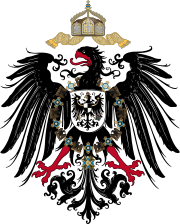
Eagle, Imperial German . used after the unification of Germany in 1871 after the Franco- Prussian war.
(German: Wappen Deutsches Reich “Reichsadler,”) The Imperial Eagle shows the “Prussian Eagle” (Its coat of arms with silver (shown as white and black quartering.) on its chest as an indicator of the dominate German state. (See “Error Stein” below.)
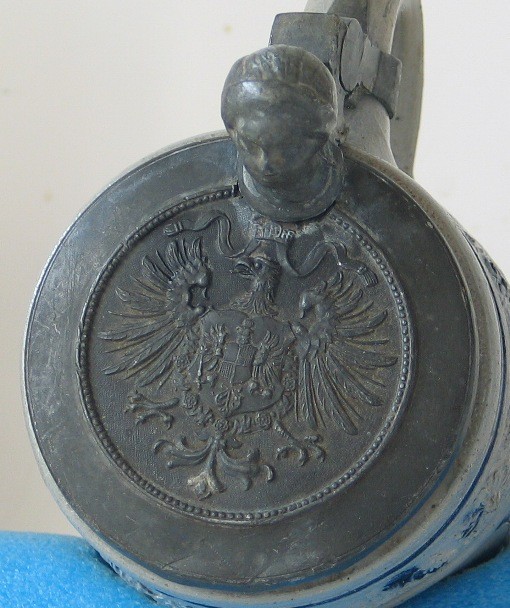
An example of the Imperial Eagle as shown on a pewter relief lid. This lid had been placed on a much earlier Westerwald stein, so it is obviously a later addition.
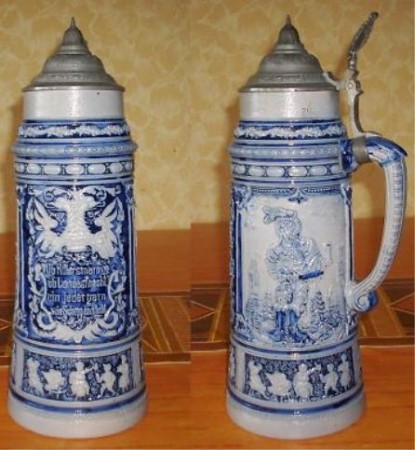
Eagle, Double headed – Symbol of the Holy Roman Empire. Used by several European Countries ,and a multitude of cities, in their official Coat of Arms
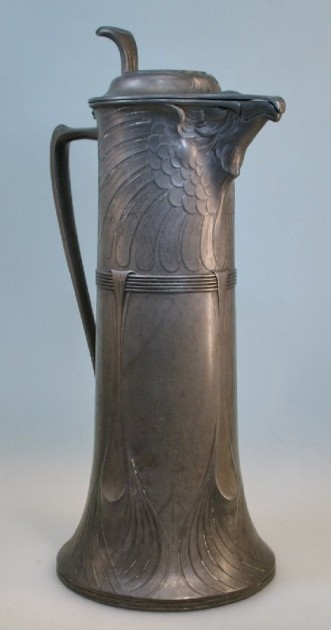
Eagle spouted steins – Not to be outdone by the silver and pewter-smiths who made these and others shown under “Adlers,” other companies had to jump on the wagon too.
See those servers posted under “Adlers” also.
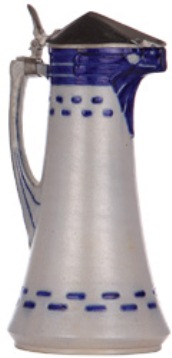
Eagle spouted Gerz Art Deco server, 3 liter, mold number 1396.
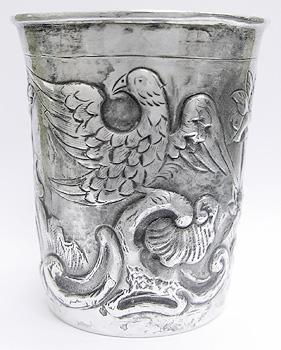
.
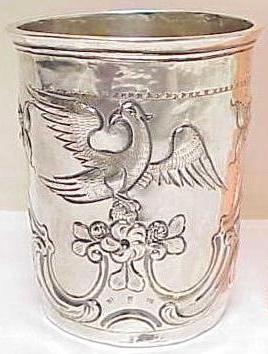
Eagle, vodka beakers – Russian, made of .875 silver in the 1700’s, these little guys are quite expensive when found. Shown top: 3.5 inch, (1787.)’
.
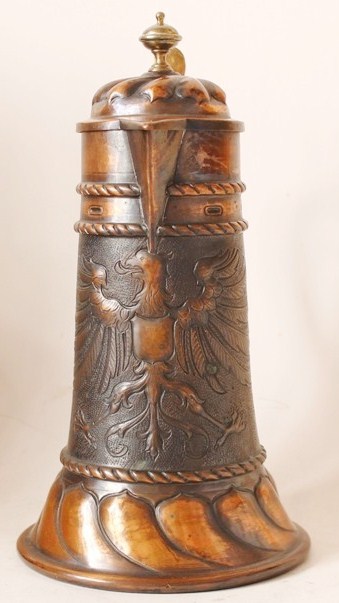
Copper eagle server. 10.5 inch. Bavarian. Ca 1880-18=9120. The eBay seller called this the Imperial Eagle – which it is not as there is no smaller eagle on its chest.
Eagle wings open – See: Spread Eagle, this Compendium.
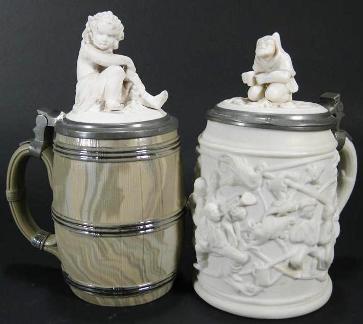
Early ware – ( V & B Mettlach,) A generic term used mostly for products produced by V & B Mettlach, or in other V & B factories prior to say 1880, when the “Golden Age” of stein production took off. There has been some recent and very worthwhile discussions / articles that a lot of “early ware” that previously was thought to have be Mettlach was not !” (Jan. 2012) and in fact a couple of other companies were involved.
Another V & B “Early ware” stein- Ende 19. Jh. (End of the 1800’s) Lots of early ware steins / vases / etc., had silver luster applied to the relief vines and leaves. It wore off rather quickly, say in a hundred years or so.
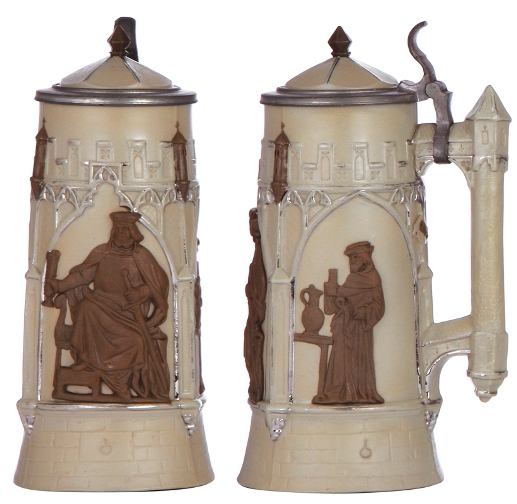
This Gambrinus relief stein above shows silver luster as accent to the design
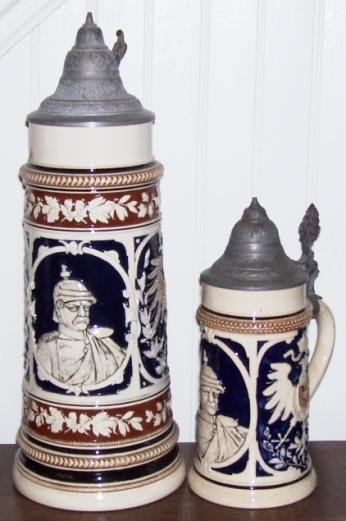
Earthenware (used the same as” Pottery”) – A non-vitrified (porous) ceramic, kiln-hardened at 850°C-1000°C. The stein requires glaze to become non-porous. Shown: Two (German) earthenware steins made for the Standard Brewery Co.’s (Baltimore, USA) line of “Bismarck Beer.” According to an 83 year old Baltimorian, (in 2013) these were given out as mugs (for smaller orders) and then steins for larger amounts of beer ordered from the bars in B-town. True ? Why not ? [L] stein is 13.5 inches tall.
Edelzinn — Display pewter cast in relief; used since the 19th century to describe German and French relief pewter of the 16th and 17th centuries.
Eggerman – A very famous Bohemian glasshütte.
The inventor of several early glass decorating technology, Mr. Friedrich Egerman (1777-1864) had his glasshütte in Novy Bor. Thanks to his talent and diligence he achieved revolutionary discoveries.
His ruby staining process was the first one to use motives of a shell, stag and the chateau and his staining and engraving technique has been adopted as the name Egermann glass forever.
The firm produced many varieties of steins and other drinking vessels. Most of the green glass steins are distinguished due to their very dark green colored glass (as opposed to Theresienthal’s light yellow green) and very bright enamels. Lost of yellows as seen above are dominant ▲.
Shown ▲: A 1/2 liter enameled armorial stein. Coat of Arms unknown, and is probably fictional. Ca 1880’s.
.
Shown below ▼: One of Eggerman’s most sought after beer steins. Lots of different work on it.Ca. 1890 [RFA].
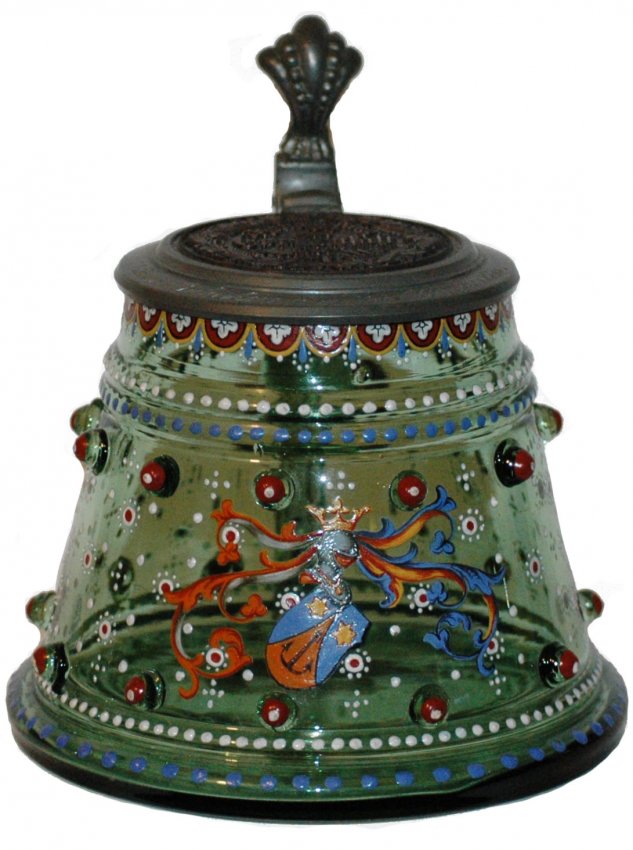
CR- Egyptian Copper BEAKER
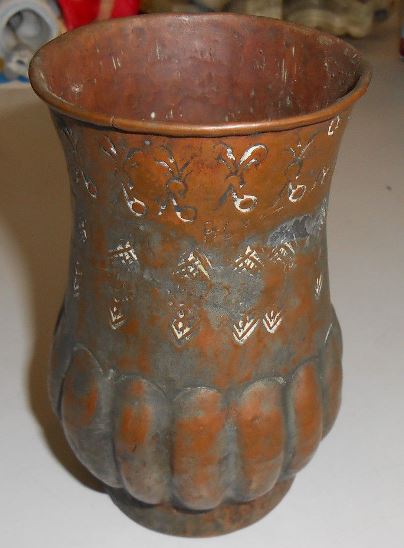
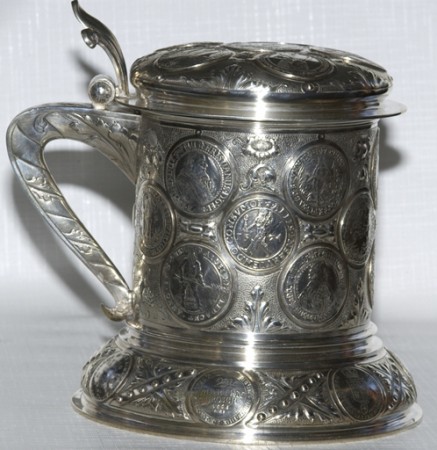
Eight hundred silver (.800) – The German standard for silver, but only after 1 January 1888. Prior to that they used the “Loth system”, which was based on 16th’s = 12 Loths would be .750 silver content; or 750 units of silver per 1000 parts total. Sterling is 925 parts per 1,000. Shown: An .800 silver coin stein from the 1920’s . It also carries the “Crescent” and the ” Crown” , all required marks . [FWTD] This great piece was sold to me as a “Humidor,” from a Georgetown, D.C. dealer, as it’s previous owner had kept his cigars in it. Gotta love it!
1888- January 1, 1888 – The date the new German Imperial Standard for silver became in effect. It required [1] the purity of the silver to be marked in a 1000/th system. For example .800 equals 800/1000 pure silver (and .200 alloy, usually of copper.) Prior to that Germany used the “Loth” system, based on 16ths, = 12 Loths would be .750 silver content; or 750 units of silver per 1000 parts total. (Sterling is 925 parts per 1,000.) [2] a stamped crescent moon, and [3] a small stamped “Imperial” crown. [4] the makers mark or name. This law was passed on 16 July, 1884 and lots of silver-smiths started using it before the effective date, so one may find steins / items dated 1884- – 87, with the new marks.
1888 – The year of the three German Kaisers – 1888 was quite a year for the German Aristocracy and one that sent Germany headlong into a disastrous course of events.
The Year of the Three Emperors, or the Year of the Three Kaisers, (German: Dreikaiserjahr; of “Drei”=Three, “Kaiser”=Emperor, “Jahr”=Year) refers to the year 1888 during the German Empire in German history. The year is considered to have memorable significance because of the deaths of two German Emperors, or Kaisers, leading to a rapid succession of three monarchs within one year.The three different emperors who ruled over Germany during this year were Wilhelm I, Frederick III, and Wilhelm II.
The mnemonic “drei Achten, drei Kaiser” (English: “three eights, three emperors”) is still used today in Germany by children and adults alike to learn the year in question.[5]
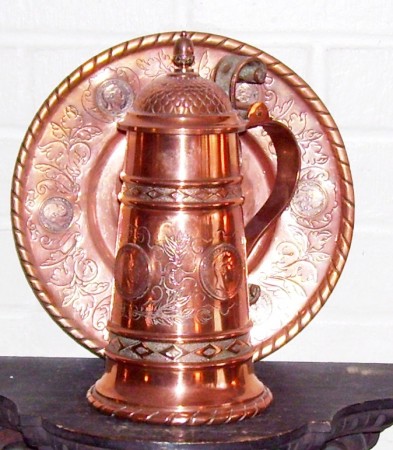
Copper beer stein showing the three copper plated coins of the three 1888 Kaisers, with matching under-plate with 6 copper plated coins (two of each.) 1888. Unknown maker and city My SWAG (mostly because of the crimped border on the plate) would be Nurnberg, and made for the Prussian market [FWTD]
Also see: “Three Kaisers, The” in this Compendium.
Eihring, Heinrich – Modern designer for R.Merkelbach / Goebel.
Eisenbahn (Railway) Steins [but not Reservist’s Eisenbahns] – Mostly occupationals. Shown: A Circa 1840’s Bohemian clear blown glass stein with enameled steam engine and cars. Quite a sight back then!
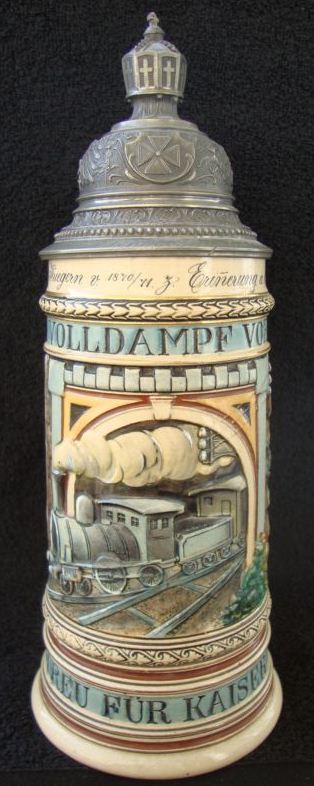
.
Eisenbahn, Reservist’s – Eisenbahns (Railway) Steins – Shown above: A different reservist’s stein on a “Occupational” .5 liter pottery relief body. Imperial German crown. Ca. 1885
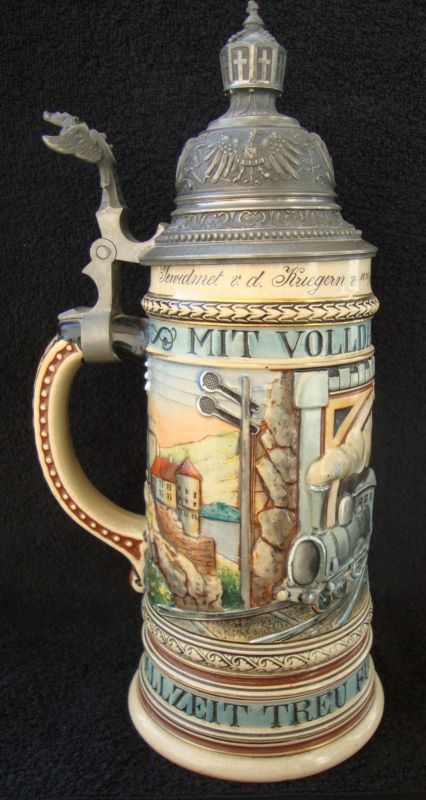
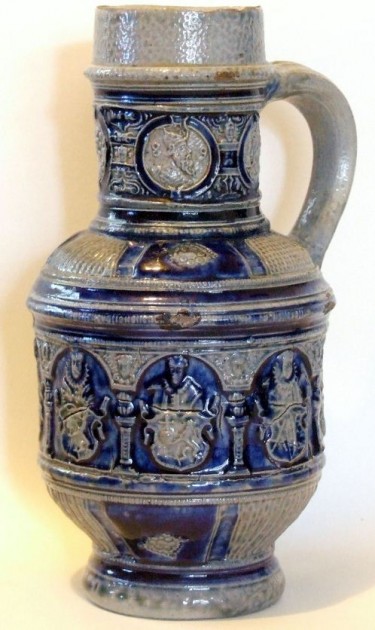
A Westerwald “Holy Roman Emperor’s Elector’s jug.” The originals are very rare, and this one is dated 1589! It has the initials IE for Jan Emens Mennicken; 15 & 89 in relief roundels at the top. The electors are holding shields with their respective Coats of Arms. The motif of this stein has been reproduced and reproduced to this day!
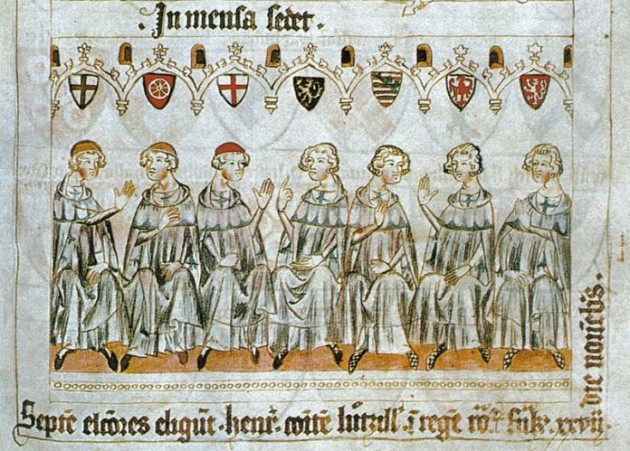
ELECTORS OF GERMANY – DTD 1341 – ARCH BISHOPS OF COLOGNE, MAINZ, & TRIER – COUNT PALATINE OF THE RHINE – DUKK OF SAXONY – MARGAVE OF BRANDENBURG – KING OF BOHEMIA
.
Electors of the Holy Roman Emperor, steins and jugs – Also known as “The Electors of Germany.” These were the great princes who had the right of electing the emperor or king from the 13th to the beginning of the 19th century. In earliest times, under the Carolingians (family of Charles the Great, or Charlemagne), the crown was hereditary; afterward Germany became formally an elective monarchy, but the election was practically limited to the reining family. These electors held a commanding position in the German Empire. The electors had many important rights, exemptions and privileges and royal dignity, but not the title of”Majesty.”
In the 13th century the right of election for a time exercised by all the princes of the empire, became limited to seven holders of the highest ecclesiastical and civil offices. Six of these were the Count palatine of the Rhine, the Duke of Saxony, the Margrave of Brandenburg, and the Arch-Bishops of Mainz, Treves [Trier] and Cologne. For some time there was doubt as to the seventh elector. In 1273 the duke of Bavaria claimed the place, but in 1289-90 the King of Bohemia was made the seventh elector. In 1623 the duke of Bavaria was added to the electors and in 1692, Hanover was made into a ninth electorate. In 1777 the number was again reduced to eight, the Bavarian electorate falling to the Elector Palatine. Their powers came to an end in 1806 when the empire was dissolved by Napoleon, but the title continued in use until 1866.
.
Shown below ▼: A very large replica / copy of a 1600’s Kruessen stein showing the Electors. Made by the A. Saeltzer firm. Those by this firm are just about as hard to find as the real ones, not many made. The detail work was very time consuming and the extra pewter base rim would make the stein more costly. [FWTD]
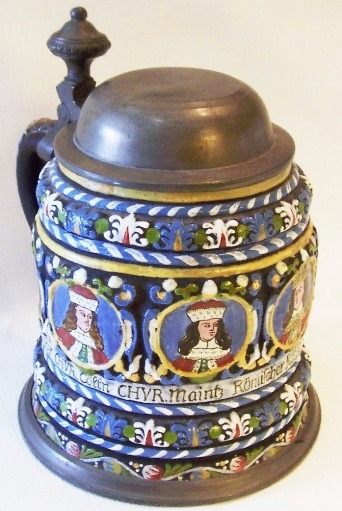
Elector’s cup – A German to English misnomer; as these are actually Humpens. Shown: A very modern replica of one for the Elector of Saxony. The reproductions that Heckert and others produced in the 1800’s have become so popular (and expensive) that the German glass factories started remaking these again in the late 1900’s.
Electroplated steins – Most often done in silver. Vessels produced by immersing a (copper based mostly) stein in a solution with silver nitrates. An electrical charge is produced inside the tank and the silver molecules collect on the copper base. The piece is then polished, but ends up having a slightly different tint than Sterling silver.

Electrotype — A copy of an art object produced by electroplating an impression of the original, then filling in the metal from the rear, the exact opposite process of electro-plating. Used in the nineteenth century to reproduce antique objects a lot of old “master pieces” were copied in this manner by Elkington and Co. They can be determined usually by the roughness in their bases, which were not finished / buffed down as E-P wares were. These are still usually expensive when found.
Shown above ▲: Elkington Electrotype tankard, circa 1860, dancing classical figures amid grapevines. The finial is an infant Bacchus. Height is 11 1-2 and it weighs 4 1-2 pounds!
Below ▼: The inscription found on some of Elkington’s copies of older steins that states where and what the piece was copied from.

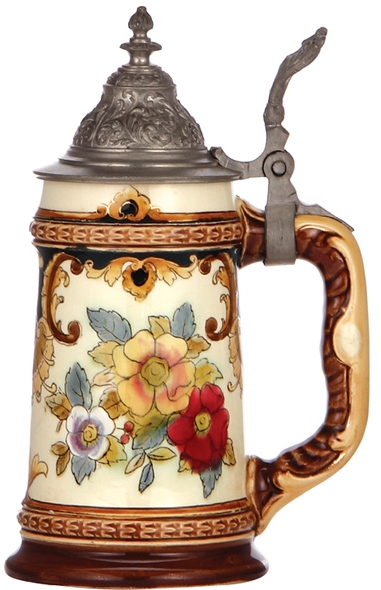
Elfenbeinsteinzeug, (Germ.) – Elfenbeinsteinzeug is made from exactly the same clay as Steinzeug, but is fired in a vented kiln which allows oxygen to enter the kiln during the process that oxidizes the small amount of iron in the clay causing the beige or ivory coloration. Rather than being salt glazed, Elfenbeinsteinzeug is covered with a glass frit glaze, safer for the environment and those who produce it. From: http://www.thepatriotexchange.com/pss/pottery.htm Shown ▲: An example made by Ditmar. Called Majolica by most collectors because of the applied bright glaze.
For more on Majolica Steins, see: http://www.steveonsteins.com/german-majolia-beer-steins-new-7-24-12
What definition goes with this stein?
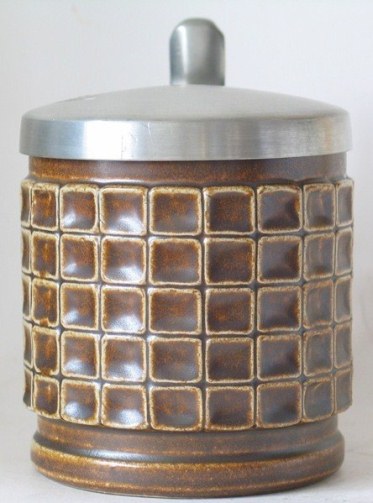
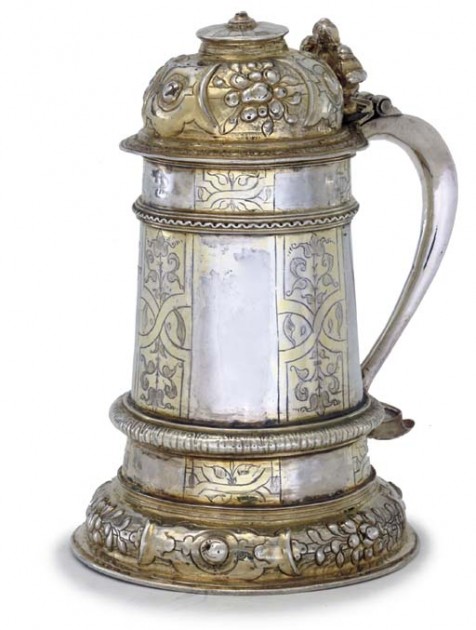
Elizabethan style tankards / steins – Silver pieces made during the reign of Elizabeth I in England. Almost all of them take the form of the one shown above ▲. Extremely expensive as most of them are in museums.
Elkington and Co. – England’s largest silver plating firm. It started in 1840. They made historic reproductions of lots of “in museum” steins. Shown above ▲: A gilded silver “Electro-type” (see just above) reproduction by Elkington of a 1600’s gilded silver stein.
For much more information, see: http://www.steinmarks.co.uk/pages/pv.asp?p=stein782
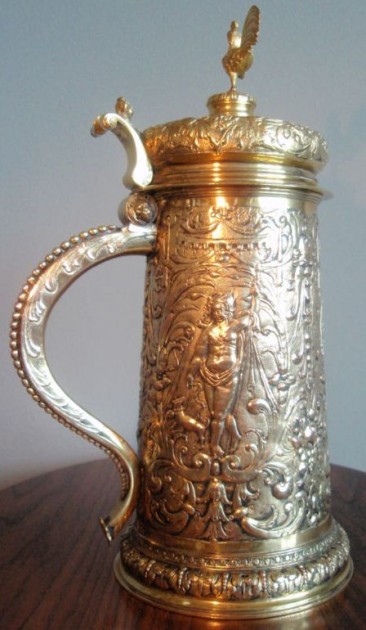
Shown above ▲: A much larger copy of an older piece. Very close in style to the one shown on the Oil-on-canvas shown as the header to this page
.
![ELKINGTON - A MASSIVE STERLING SILVER BEER SERVER - DTD. 1925 - FROM A ST. GEORGE SOCIETY [3]](http://www.steveonsteins.com/wp-content/uploads/2011/01/ELKINGTON-A-MASSIVE-STERLING-SILVER-BEER-SERVER-DTD.-1925-FROM-A-ST.-GEORGE-SOCIETY-3.jpg)
Elkington is not as well known for its work in sterling , but they did produced some great looking pieces. This giant (and weights a ton) beer server was the center piece on the meeting room table at some Saint George;’s Society Fellowship hall. [Stephen Smith collection].
.
![ELKINGTON - A MASSIVE - BIRMINGHAM FINIAL ON MASSIVE SILVER BEER SERVER - DTD. 1925 [2]](http://www.steveonsteins.com/wp-content/uploads/2011/01/ELKINGTON-A-MASSIVE-BIRMINGHAM-FINIAL-ON-MASSIVE-SILVER-BEER-SERVER-DTD.-1925-2.jpg)
Detail of the above finial .; also sterling.
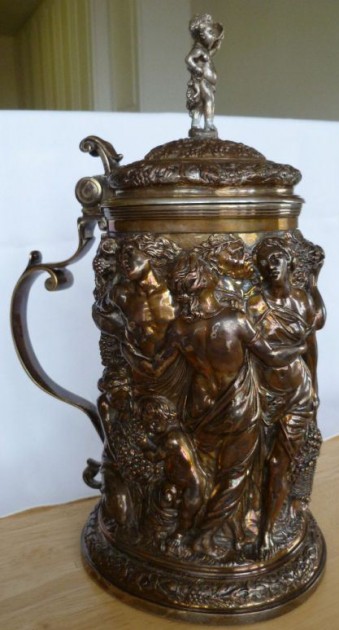
Elkington Mason and Co. – Mr. Mason was a latter day partner in the firm. The company prodeced their tankard reproductions in the same manner and marked them the same as the older firm. (see photo below ▼)
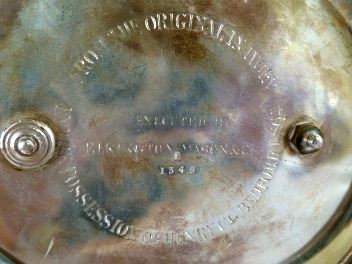
The circular inscription says: “COPIED FROM THE ORIGINAL IN THE PROCESSION OF .”, Elkington Mason and Co. (and stamped mold No.) 1348.
FOR MUCH MORE INFO ON THESE FIRMS SEE: http://www.steinmarks.co.uk/pages/pv.asp?p=stein782
Elks – (THE BENEVOLENT AND PROTECTIVE ORDER OF ELKS ) See the listing and photo under the word “BUTT”,
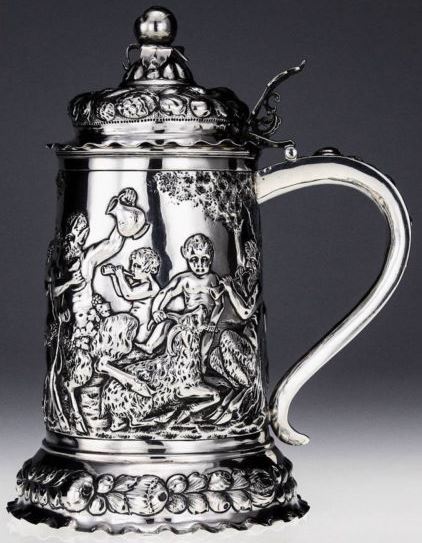
Embossing — Similar to repoussé in appearance, but used mainly to create relief designs achieved in one action, such as those impressed by a shaped metal die. This is used sometimes to describe “relief” steins which are molded not embossed. Shown: A Hanau made pressure stamped, silver stein called “hand made and relief “by a USA Stein auctioneer in 2014. The only part of it that was hand made was the silver soldering of the seam, and subsequent cleanup.
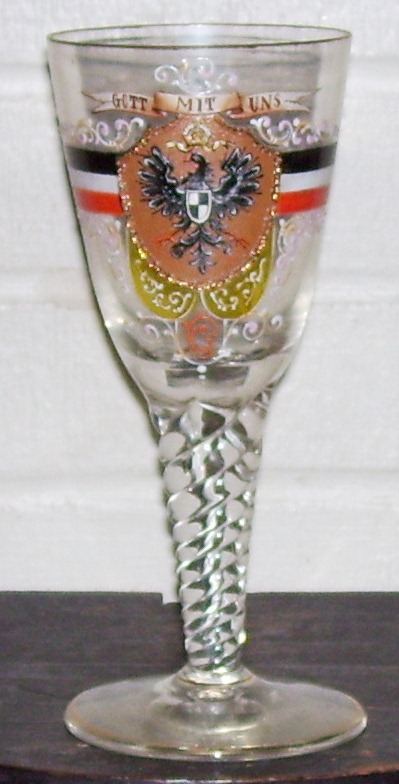
Enamel — Enameling is an old and widely-adopted technology, for most of its history mainly used in jewelry and decorative art. Applies to several processes of painted decoration, usually on glass or metal, and then fired. Originally made of crushed colored glass.
Vitreous enamel, also porcelain enamel in US English, is a material made by fusing powdered glass to a substrate by firing, usually between 750 and 850 °C (1,382 and 1,562 °F). The powder melts, flows, and then hardens to a smooth, durable vitreous coating on metal, or on glass or ceramics.
Shown above: An example of “Heavy Enameling” on a Josephinahutte blown glass beaker showing the Prussian Eagle, but with the Imperial colors of red, white and black and the Imperial Crown. A bit strange as far as real heraldry is concerned [FWTD]
.
The term “enamel” used to be most often restricted to work on metal, as shown below ▼:
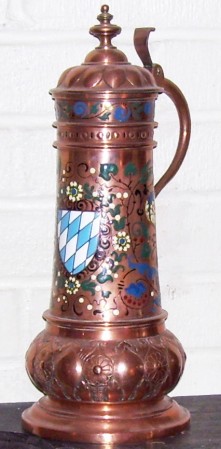
Copper serving stein with cloisonné, this piece, Bavarian (probably Munich). The shield is from the Wittlebach’s family, the old ruling family of Bavaria. [FWTD]
Enameled glass is also called “painted”. Fired enamelware is an integrated layered composite of glass and metal. Used as a noun, “an enamel” is a usually small decorative object, coated with enamel coating.
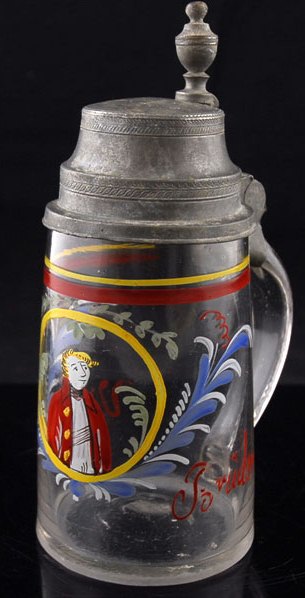
A great example of a “painted enamel” stein. Bohemian. A one liter blown glass stein. Circa 1780 – 1820.
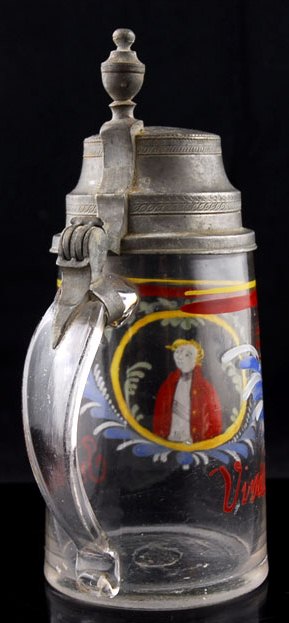
Detail of the [1] flat handle of blown glass with “pig tail” and [2] the unfinished “pontil mark” which indicates a late 1700’s date.
Since the 19th century the term “Enameled” applies also to industrial materials and many metal consumer objects, such as some cooking vessels, dishwashers, laundry machines, sinks and tubs, etc.
See photo below ▼:
Enamel steins, baked – The other name for kitchen pots/ pans produced this way is “spatter -ware.” These are hand painted touch up PUGs on an enameled tin body; made like a thermos, with the inside cup coming down into the body and no closed base so the air can circulate around it. The one shown ▲ has had a full metal base added later. German, one liter. Circa 1900.
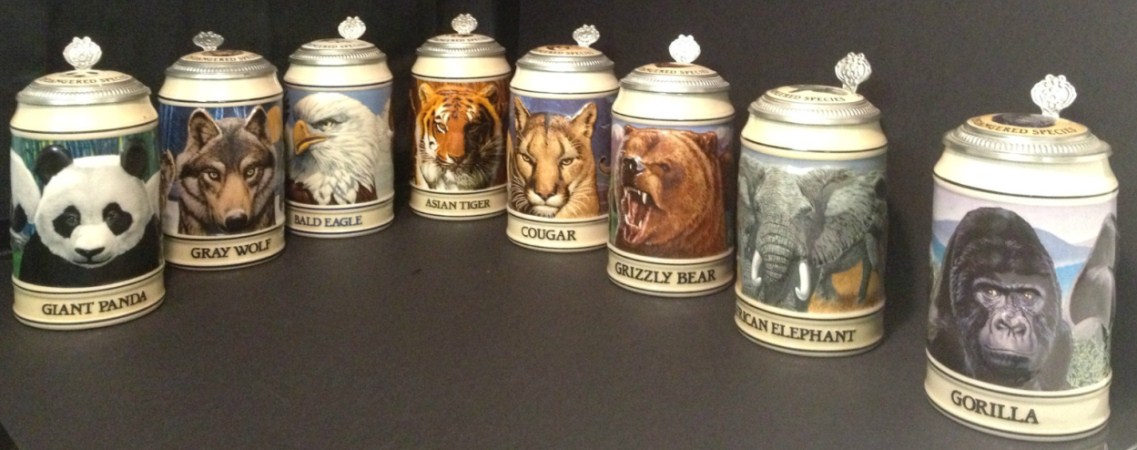
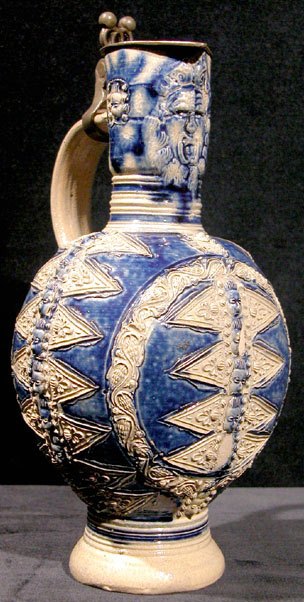
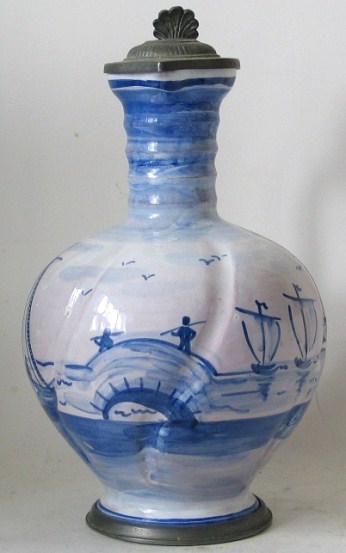
English style steins (tankards . – This subject is for those very new to the drinking vessel collecting game . The English styles for vessels are 95% completely different from those on the European Continent. And once established have remained fairly constant for years. Starting at the earlyiest examples shown above under “Elizabethan style tankards / steins” Once the major forms are learned it will be possible to spot an English example from across the room at a shop or mall and be able to quickly make up ones mind if one wishes to see it.
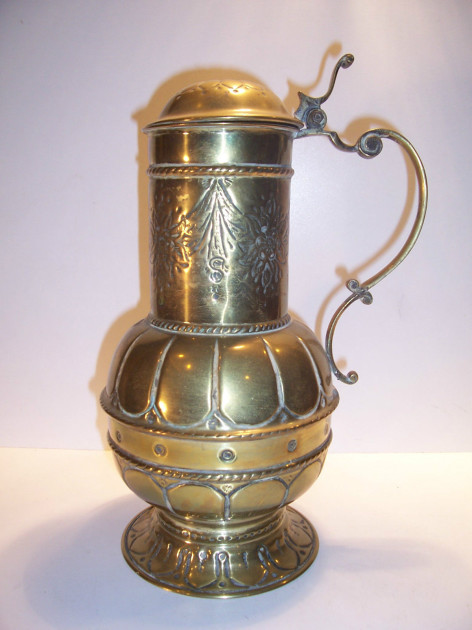
A populat style for Silver and brass – which was well thought of in England in the late 1600 and 1700’s which is when this piece probably was produced. most are marked.
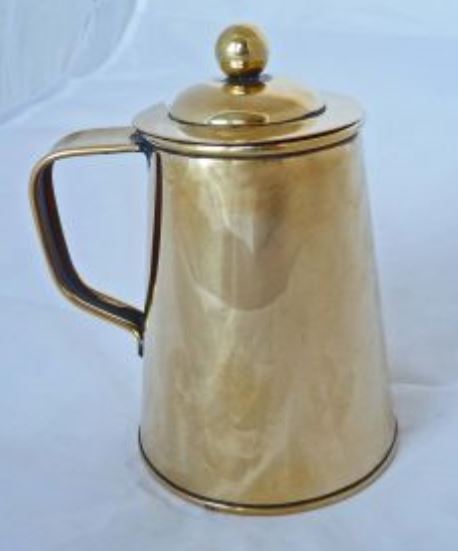
The lid is attached by a very small hinge and soldered directly to the top rim body.
The English coppersmith ▲was Henry Loverridge. Ca. 1800.
.
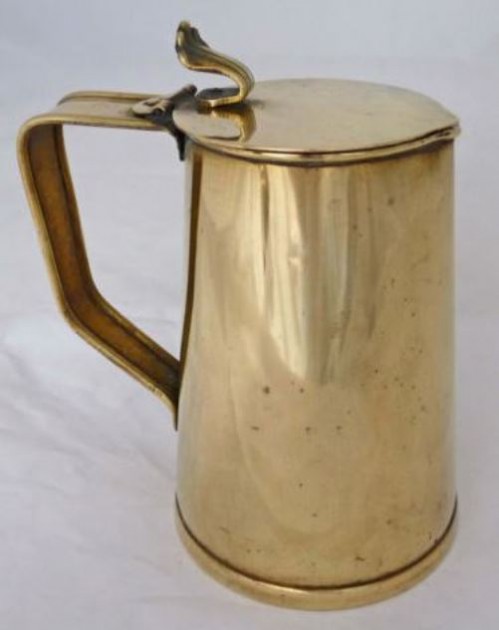
A nice simple design brass tankard / server by Joseph Sandkey.
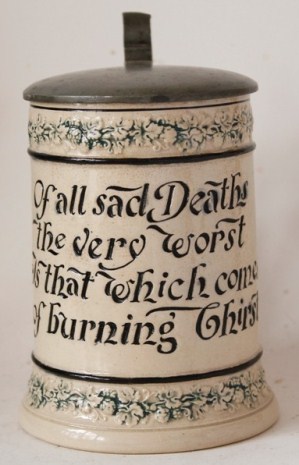
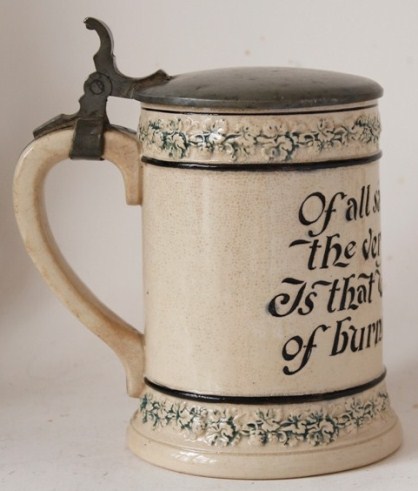
English verse steins = The USA (Great Britain was second) was a big importer of German beer steins around the turn of the 19th to the 20th century, several German firms made steins with English verses on them for that market. Many of these were made by Gerz. as shown above▲
A friend of mine , a member of Gambrinus Beer Stein Collector’s Club had his two Girls learn German in school and he participated by getting into a program where a female German teenager would come over to the States for a year to be a paid Nanny (A-pare. SP?). The next year it would be another girl ,and so on. One particular young lady really hit it off with his family and so when Bill and his wife went to Germany they stayed with the Nanny’s family. He had me be on the look out for him to find some English versed stein for presents as a interesting turn around on gifts. I thought that was a novel idea!
,
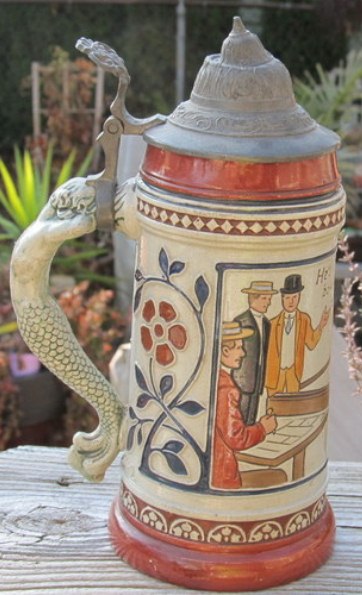
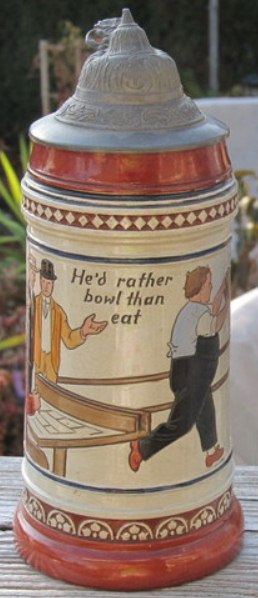
.
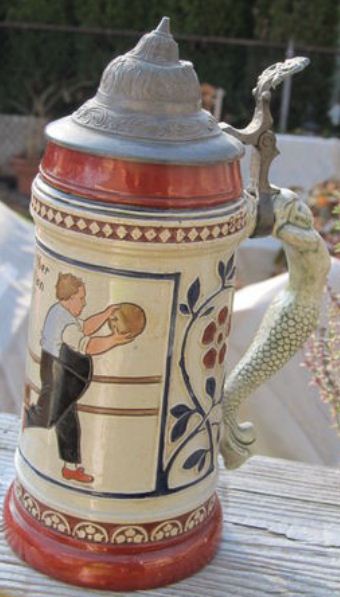
“He’d rather bowl than eat!” German but made for the American / English speaking markets. Ca 1900. Why the mermaid handle? I do not know as it has no significance to the scene.
Englisch Zinn (Pewter) — A mark used to indicate that the metal was purified to English standards, or using English tin. See also “Feinzinn.”
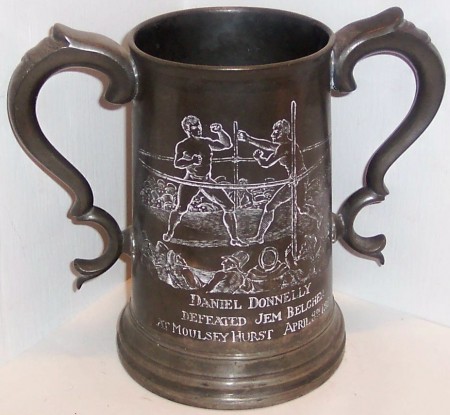
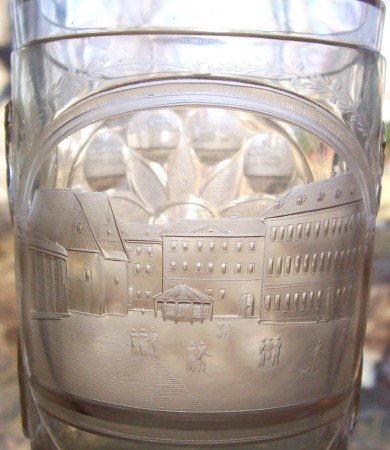
Engraved – [2] Glass – [OVER SIZED PHOTO SHOWING THE GREAT DETAIL ]
The process of using, most often a copper wheel or a diamond point tool, to grind into the surface of glass to make design or words. The Bohemians in the early to mid 1800’s were masters of doing this. Shown: I have blown the photo up so one can see the great amount of detail one can see. A small dog can be seen in the right foreground by a standing man . This was all engraved on a 3 inch cartouche, on the front of the 6 inch body!
Both engraved and incised steins are mostly called “etched” (which uses acid to make the design) by the vast majority of un-educated beer stein buyers. See “Etched”below ▼:
EPC — Electroplate on copper.
EPBM — Electroplate on Britannia metal.
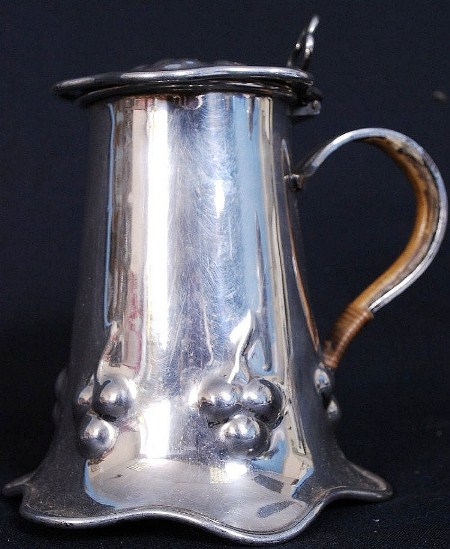
EPNS — Electroplate on nickel silver. Shown: ESPN by Charles Favel of Sheffield.having embossed design, base marked: “C and F / EPNS”
EPWM — Electroplate on white metal [spelter].
Erfurt 1716-1792 – City or town of major fayence stein production. For more info, see: http://www.thepatriotexchange.com/pss/hisfai.htm
Cr- EROTICA ON INSIDE THE LID VERY UNUSUAL TO SEE ‘COUPLING’ ON STEINS ca. 1880[ Czech Republic ]
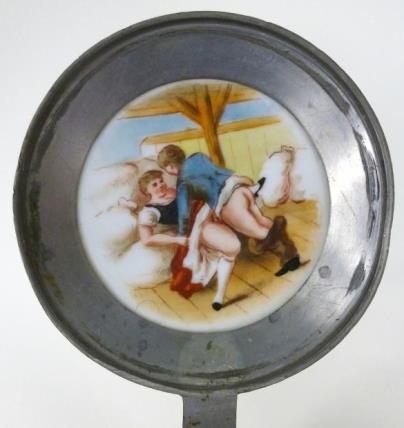
Error steins – Goof-ups, Friday’s steins, etc. Simply steins showing an error in design or execution.

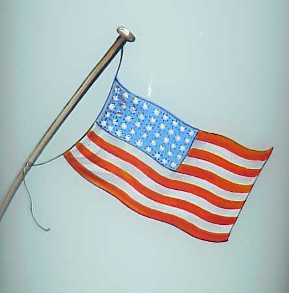
How many of these steins does one think were made before someone realized there were only 11 stripes shown on the US’s flag? They do shown 45 stars, which makes the stein made somewhere between January 1896 (Utah) and October 1907 (Oklahoma), assuming the dumb asses had counted the number correctly from a model! Any of my readers have, or seen a corrected copy?
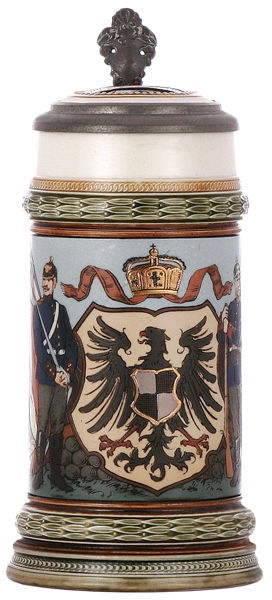
V&B Mettlach stein, .5L, 1732, etched, inlaid lid. This stein has the correct shield and display for the Prussian Eagle. Notice the silver quarters are (always) to the top left and bottom right.
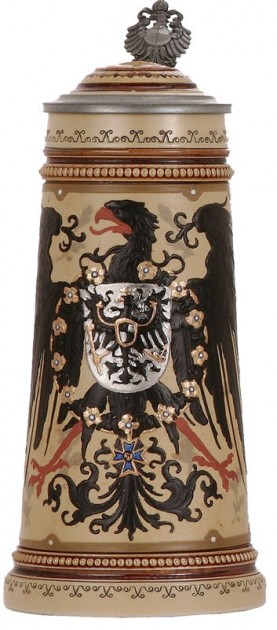
V&B Mettlach stein, 1.0L, 2204, decorated relief, inlaid lid,. Incorrect colors of the “quartered” shield (white represents silver) of the Prussian eagle, which placed on the Imperial Eagle’s chest.
The two above show one good example of an error stein. As Prussia was the dominant state in Germany after 1871, so then the Imperial German Arms were of a larger eagle with the Prussian Eagle on its chest. One will notice that for some reason the colors on V & B stein No. 2204, just above ▲, were reversed. Poor quality control!
Below ▼: Another good example of not getting the colors in the right location. In official heraldry any item that is engraved and not painted onto, then red is shown with incised vertical lines.
The pewter charger below shows one of the two Coats of Arms of Nurnberg that city uses. As the other one the present official version shows a king ‘s head and body with wings. Long ago it was a “Harpie” (see such in this site’s Compendium.)
The colors are not shown correctly. On the plate’s shield’s left side (facing the reader always), from top to bottom is: white, red. white, red, white, red. Whereas on the official arms the colors always were started with red on top ending in white on the bottom!
As this 9 inch pewter plate was probably made as a souvenir, the buyer probably didn’t know any better, but I wonder how it could have slipped through the master of the shop though? Anything for a Mark or two, even back then. Or giving them the benefit of doubt, perhaps as a learning tool?
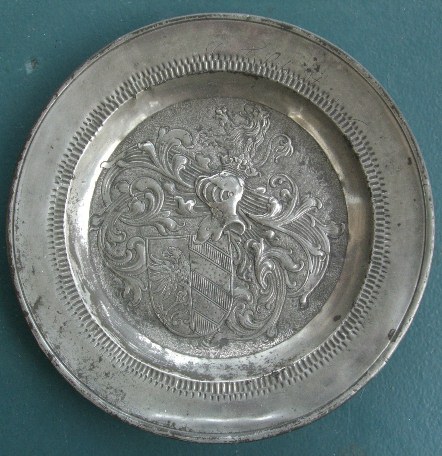
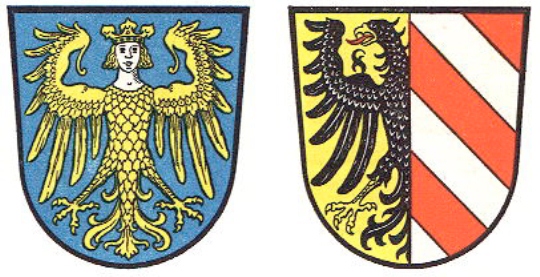
Etain – French word for “pewter.” If one sees this mark, the piece was made most likely after WWI (1919.)
Etched pottery / wood / metal – A common misnomer used to mean that the design was “incised” into the pottery or wood or metal stein, by using a hand tool, OR a mold that makes incised lines that look like they were hand done. Real “etched” work is done by using acid! Shown ▲: A very nice hand tool engraved / incised (not etched) 11 inch tall stein from the Westerwald. Circa mid to late 1700’s. [FWTD]
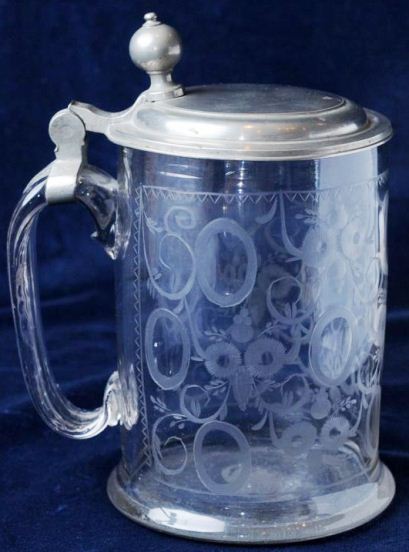
Etched glass – A misnomer and sometimes a big mistake. “Etched” in this case means making designs by using acid on glass or metal! New collectors will hear even older SCI’ers and most stein dealers still calling engraved glass “etched!” Very few steins were ever really etched; way too time consuming. Shown: A late 1700’s engraved Swedish mouth blown stein. The circle designs and florals were all done by hand, with a copper wheel; not etched with acid! [FWTD]
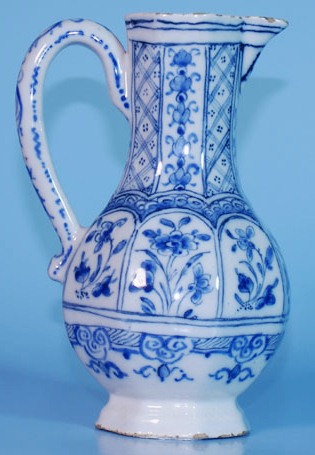
Ewer – Mostly lidless, smaller pitchers usually for serving water, sometimes wine. Or in older times water used for cleaning hands at the table. Shown: An 18th century Delft (Dutch Fayence) ewer. Ca. mid 1700’s
[END – SP104 – 74 – R5]
 My 42 year old son is in shape Round is a shape isn’t it?
My 42 year old son is in shape Round is a shape isn’t it?

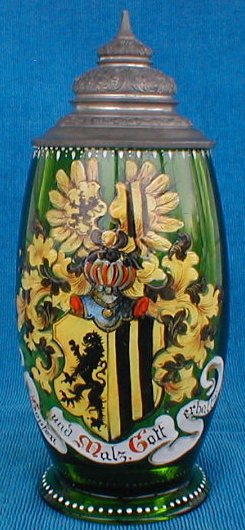
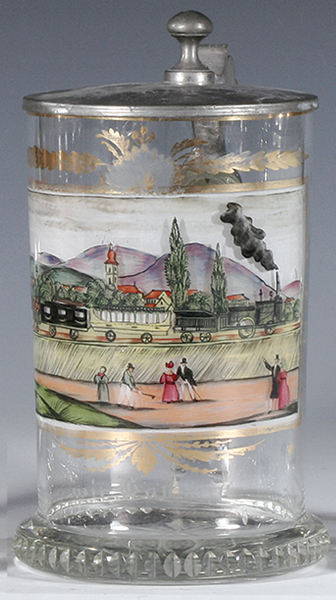
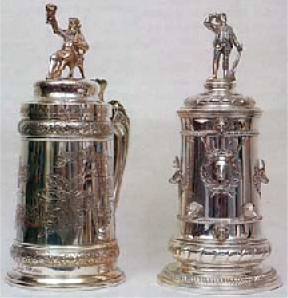
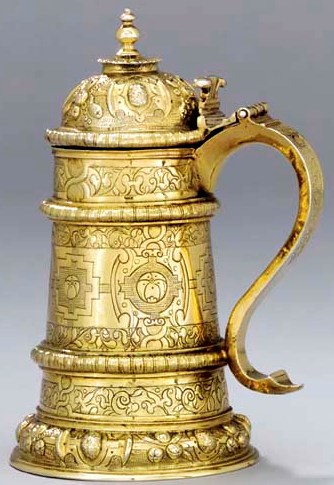
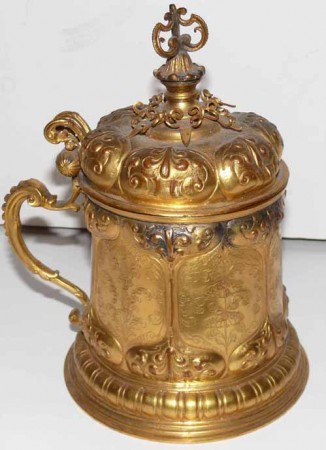
![1W BAKED enameled are name is [q]](http://www.steveonsteins.com/wp-content/uploads/2010/07/1W-BAKED-enameled-are-name-is-q-319x600.jpg)
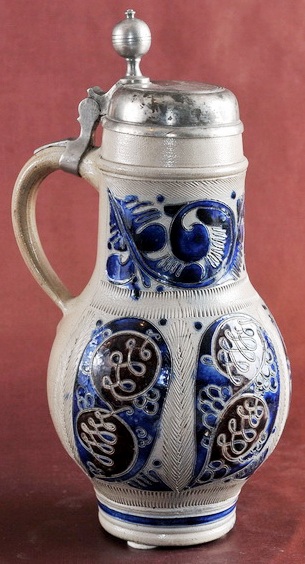
Leave a Reply